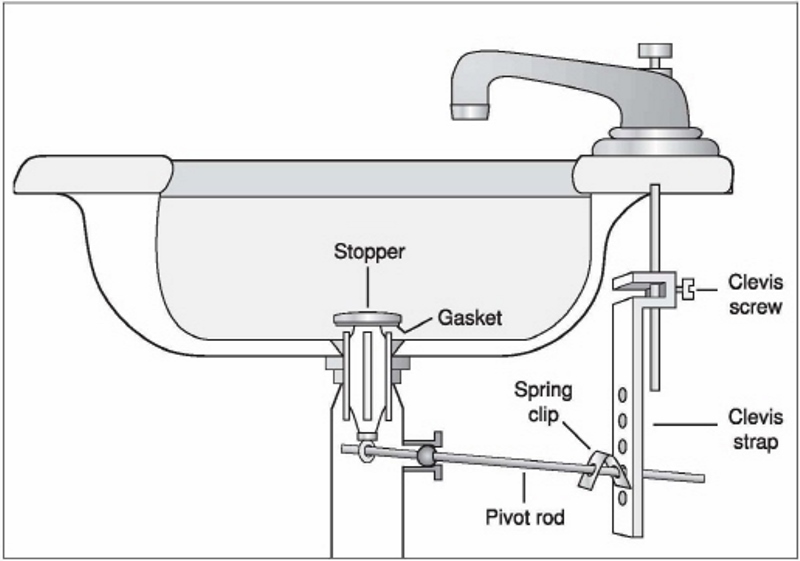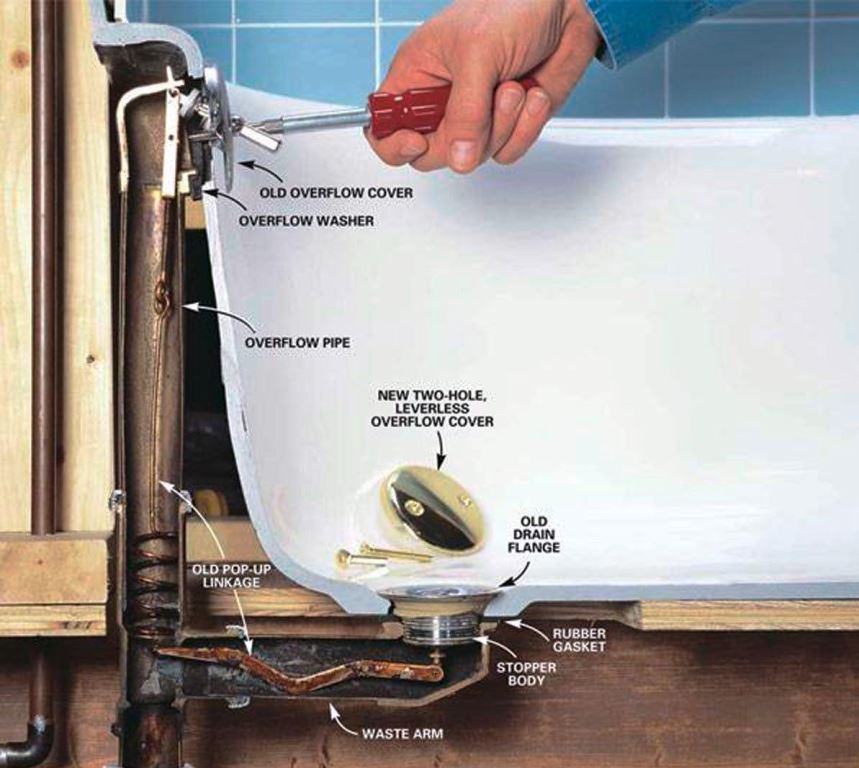When a pop-up in a sink or bathtub pug doesn’t work, how do you fix it? This expert guide from – αποφράξεις Athens – shows how pop-up sink plug work and how to fix them when they don’t.
Pop-ups are simple mechanical tools that use a system of connections and levers to move pipe stoppers up and down to seal a sink basin or bathtub. Although they look complicated, it’s almost easy to fix a pop-up stopper.
How a Pop-Up Stopper Works
Pop-ups are simple automatic tools that use a system of links and levers to move drain stoppers up and down to seal a sink bowl or bathtub. Bathroom sink pop-ups are raised and lowered with a lift handle or bar, usually placed on or near the faucet body. The handle or bar is attached to a lift cylinder that is embedded in many cases to a flat, slotted bar called a “clevis.”
The flat, slotted clevis is attached by a little spring clip to a pivot rod ball assembly. The rod that runs through a rubber pivot ball and tilts slightly upward to the tailpiece of the stopper. This rod pushes the stopper up or lets it drop down into the drain body.
The lever operates a lift linkage that pulls on a spring. The spring pulls a rocker arm that raises and lowers the stopper.
Pushing the knob and the lift rod down causes the axle rod to push the stopper up. Pulling the knob causes the pivot rod to pull the stopper down. If you want to remove the device, you may be able to pull it right out. On a bathroom sink, it’s often required to push the securing nut and extract the pivot rod first. You may have to turn the stopper to unhook it from the pivot rod.
It is usually very easy to pull out the stopper and rocker arm linkage. An old bathtub pop-up is raised or lowered with a lever at the tub’s overflow plate.

How to Remove a Bathtub Pop-Up Drain Stopper
It’s easy to remove a tub stopper to check it for mechanical problems or blockage. You’ll encounter a couple of different types of bathtub pop-ups: old-style mechanisms like the one shown in our illustration above, and newer spring-loaded pop-ups.
To remove an old-style bathtub pop-up:
1. Simply grip the stopper body and pull it out of the drain along with the hinged rocker arm.
2. Clear the stopper and rocker arm of hair and debris.
3. Check the rubber seal for damage and, if necessary, replace it. Remove the old seal and slip on a new one if needed.
4. Reinstall the stopper and rocker arm. Make sure the flange is tightly seated and in good shape. (Older tubs may have corroded flanges.)
How to Fix a Bathtub Pop-Up Drain Stopper
Quickly:
- Remove the screws that secure the overflow cover plate.
- Pull the plate and lever away from the overflow hole, partially pulling out the mechanism.
- Adjust the nut on the linkage—lengthen it to raise the stopper or shorten it to let it drop lower.
- Push the assembly back in and replace the cover plate.
- Lift out the stopper and rocker linkage. Check the seal, remove hair and debris, and then push it back into the drain.
Totally:
A common issue with bathtubs is that the pop-up stopper doesn’t close completely, match the drain flange tightly, or open easily when the lever or knob is involved. Stoppers that don’t close can keep the tub from filling well, through losing water. Stoppers that don’t open immediately or don’t open all the way make tub drain sluggishly.
A bathtub pop-up is a two-part mechanism: first, the stopper, which has a rocker arm that extends back toward the drain, and second, the overflow assembly, a lever that lifts or lowers a rod with a spring-like end. When you flip the overflow lever up, it pushes the rod down on the stopper’s rocker arm, which raises the stopper. Flip the lever up, and it lifts the rod, allowing the stopper to drop down and plug the drain. Depending upon the type of pop-up, you adjust the way the stopper seats either by adjusting the length of the striker rod or by adjusting the rocker arm.
To adjust the overflow device
Extract the screws that secure the overflow cover plate, and pull the plate and lever away from the overflow hole, partly pulling out the device. Settle the nut that lengthens or shortens the rod assembly. You can lengthen it to raise the stopper higher or shorten it to let it drop lower. Then push the assembly back in and replace the cover plate.
To adjust the stopper
Simply lift it out of the drain along with the rocker arm. Check the rubber seal, if there is one, for damage, and replace it if need be. Clean off hair and debris, and adjust the nut on its underside to shorten or lengthen its connection to the rocker arm. Then work the arm and stopper back down into the drain hole to make sure the flange is tightly seated (though older tubs may have corroded flanges).
Keeping the drain clear of hair, soap and shampoo residue, and other debris is one of the best ways to help keep the stopper in good working order.

How to Fix a Sink Pop-Up Drain Stopper
Water may leak or refuse to drain around a sink pop-up for some reasons. If your sink pop-up won’t pop up or seat properly, fixing it is quite easy—usually just a matter of adjusting a few parts. The culprit is often a build-up of hair around the base of the stopper or the pivot rod mechanism. Or, the clevis may be out of adjustment (see illustration to identify the various parts).
Pushing the knob and the lift rod down causes the pivot rod to push the stopper up. Pulling the knob causes the pivot rod to pull the stopper down. If the stopper sits too high or not high enough in the drain, go under the sink with a flash light and identify these parts, per the illustration above. Pinch the spring clip to release the flat bar (clevis) from the pivot rod. Then move the rod up or down into a different hole in the clevis and replace the spring clip.
In many sinks, hair and crud accumulate around the body of the stopper, clogging the drain. You have to extract the stopper to clean it. On some sinks, you may be able to pull it right out. But it’s often necessary to work under the sink. You must remove the retaining nut (slip-joint pliers can help if it’s frozen shut) and pull out the pivot rod first. You may have to turn the stopper to unhook it from the pivot rod.
Here’s more detail on how to fix the problem:
- With a slight twist, try to lift out the stopper. If it seems to be linked to the mechanism below, reach under the sink and unscrew the pivot rod retaining nut and pull out the pivot rod to disengage it. Use locking-jaw pliers to loosen it if necessary.
- Lift the stopper from the drain. Clean off all hair and debris. If the stopper is broken or its seal looks worn, replace it.
- Face the hole at the bottom of the stopper toward the pivot rod’s location, and drop the stopper back into the drain hole. Insert the pivot rod so that it engages the hole in the bottom of the stopper, and tighten on the retaining nut with the stopper in its up position. When the drain is closed, the pivot rod should slope slightly uphill from the clevis to the tailpiece.
- Loosen the set screw on the clevis and adjust the strap up or down so that it operates the pivot rod to open and close the stopper. Retighten the set screw.
- If adjusting the clevis screw doesn’t help, reset the pivot rod by squeezing the spring clip and freeing the pivot rod. Move the clip up to the next clevis hole and insert the rod. You may need to keep tweaking this a little to find the right hole on the clevis.
- If water drips from around the pivot ball, tighten the retaining nut that holds the ball in place. You may also need to replace the gasket or washer (or both) inside the pivot ball-and-rod assembly.
Keeping drains clear of hair, soap and shampoo residue, and other debris is one of the best ways to help keep pop-up stoppers in good working order.
Read more about plumping problems in Athens
- ΑΠΟΦΡΑΞΕΙΣ ΩΡΩΠΟΣ 210.80.55.866 ΑΠΟ 20€ ΕΩΣ 40€!
- ΑΠΟΛΥΜΑΝΣΕΙΣ ΕΞΑΡΧΕΙΑ ΑΠΕΝΤΟΜΩΣΕΙΣ ΕΞΑΡΧΕΙΑ ΜΥΟΚΤΟΝΙΕΣ ΕΞΑΡΧΕΙΑ
- ΑΠΟΛΥΜΑΝΣΕΙΣ ΚΟΛΩΝΑΚΙ ΑΠΕΝΤΟΜΩΣΕΙΣ ΚΟΛΩΝΑΚΙ ΜΥΟΚΤΟΝΙΕΣ ΚΟΛΩΝΑΚΙ
- ΑΠΟΦΡΑΞΕΙΣ ΑΓΙΑ ΒΑΡΒΑΡΑ 210.26.96.745 ΑΠΟ 20€ ΕΩΣ 40€!
- ΑΠΟΦΡΑΞΕΙΣ ΑΓΙΑ ΠΑΡΑΣΚΕΥΗ 210.26.96.745 ΑΠΟ 20€ ΕΩΣ 40€!
- ΑΠΟΦΡΑΞΕΙΣ ΑΓΙΟΙ ΑΝΑΡΓΥΡΟΙ 210.26.96.745 20€-40€!
- ΑΠΟΦΡΑΞΕΙΣ ΑΓΙΟΣ ΑΡΤΕΜΙΟΣ 210.80.55.866
- ΑΠΟΦΡΑΞΕΙΣ ΑΓΙΟΣ ΔΗΜΗΤΡΙΟΣ 210.99.69.169 ΑΠΟ 20€ ΕΩΣ 40€!
- ΑΠΟΦΡΑΞΕΙΣ ΑΓΙΟΣ ΕΛΕΥΘΕΡΙΟΣ 210.99.69.169
- ΑΠΟΦΡΑΞΕΙΣ ΑΓΙΟΣ ΙΩΑΝΝΗΣ ΡΕΝΤΗΣ 210.26.96.745 ΑΠΟ 20€ ΕΩΣ 40€!
